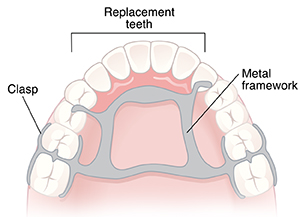Treatment for Replacing Your Missing Tooth or Teeth: Partial Dentures
Your smile lights up your face, but having missing teeth may make you feel too self-conscious to smile. If you have one or more missing teeth, your healthcare provider may recommend partial dentures. Read on to learn more about this treatment choice.
What are partial dentures?
A removable partial denture is one or more replacement teeth supported by a metal or plastic frame. It does not attach as securely in your mouth as other kinds of restorations and may take time to get used to. You will need to have your dentist regularly adjust its fit.

Types of attachments
Most partial dentures are attached or held in place by metal clasps. These clip onto the teeth on each side of the gap. But in some cases, your dentist may suggest a precision attachment. With this method, a connector fits into a slot prepared in the crowned supporting tooth.
What to expect during treatment
Your treatment experience may be as follows:
-
Preparing your mouth. Before getting a partial, you may need some other dental work. Teeth may need to be removed or reshaped. Bone may need to be built up. Your dentist will take an impression of your gums and remaining teeth and your partial denture will be made from this impression. You may wear a short-term (temporary) partial while the lab makes your final one. If so, your dentist will advise you about when and how to take it out and clean it.
-
Fitting your partial. Once your final partial is made, your dentist will make the first of many adjustments to it by checking for pressure spots on your gums. Your dentist will also make sure the look and bite are good. You will learn how to put it in and when to take it out. Plan to visit your dentist twice a year to have your partial checked and adjusted, if needed.
Getting used to a partial denture
Your partial denture will feel awkward for a few weeks. It's likely to affect your speech and your mouth may water a lot at first. Keep wearing the denture. That way you will get used to it sooner. Here are some tips:
-
Practice reading out loud until your tongue adjusts to the feel of the denture.
-
Practice putting the denture in and taking it out. Never force it into position by biting down. That could bend or break the clasps.
-
Eat soft foods at first. Don't eat sticky or hard foods. Cut all foods into small pieces.
-
Chew slowly using both sides of your mouth.
Care over the years
Your mouth naturally changes shape over time. To keep up with those changes, your denture must be adjusted. If it’s not, it will feel less comfortable. Worse, it may irritate your gums and speed up bone loss in your jaw. To get the best results with a partial denture:
-
See your dentist as instructed to have the partial checked and adjusted. Never adjust or repair it yourself.
-
Take it out at bedtime to let your gums rest.
-
Prevent gum problems and decay by keeping the support teeth especially clean.
-
When cleaning the partial, hold it over water or a towel. This way it won’t get damaged if you drop it. Clean dentures with a denture care product and denture-cleaning brush. Don’t clean the partial with toothpaste or with products containing bleach. Toothpaste can be too harsh on dentures and bleach attacks the metal.
Online Medical Reviewer:
Jessica Gotwals RN BSN MPH
Online Medical Reviewer:
Michael Kapner MD
Online Medical Reviewer:
Rita Sather RN
Date Last Reviewed:
12/1/2022
© 2000-2025 The StayWell Company, LLC. All rights reserved. This information is not intended as a substitute for professional medical care. Always follow your healthcare professional's instructions.